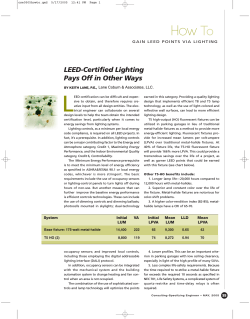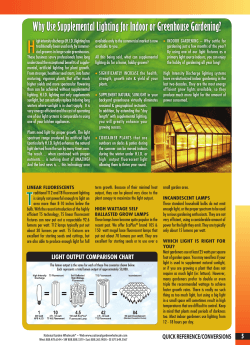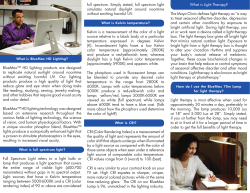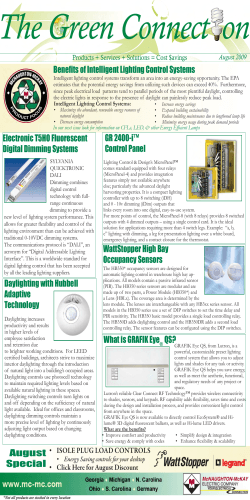
Product Manual Model: TG15A Solid State Volumetric Lighting for plant growth
Solid State Volumetric Lighting for plant growth Product Manual Model: TG15A www.totalgrowlight.com Solid State Volumetric Light Packages (SSVL) TotalGrow TG15A Light Fixture (Actual product may vary due to product enhancement) 1 TOTALGROW TG15A OWNER’S MANUAL REV13 11/19/2013 Table of Contents Overview o o o o Product Description Applications Solid State Volumetric Grow Technology Advantages 3 3 3 4 Getting Started o o o o o Package Contents Key Components of Light Fixture Safety Installation Maintenance 5 5 5 6 8 Product Notes o o o o o Available Models Product Specifications Light Spectrum Light Output Setup & Coverage 10 10 11 12 14 Support o o o o Warranty Returns & Refunds Terms of Sales Contact 15 15 16 16 Appendices o A: Old Lighting Technologies o B: Solid State Volumetric Grow Technology o C: TotalGrow Spectral Efficiency 2 TOTALGROW TG15A OWNER’S MANUAL REV13 17 25 27 11/19/2013 Overview Product Description Thank you for purchasing the TotalGrow TG15A Light Fixture. Your new grow light fixture is designed to maximize plant growth for a wide range of applications. The grow light fixture, powered by Solid State Volumetric Lighting Technology (SSVL) delivers a high quality light spectrum with highly uniform light coverage for uniform plant growth. It’s easy to install and can provide significant energy savings. Applications Commercial greenhouses, home gardens (indoor), nurseries, hydroponic centers, garden centers, universities and research institutes. Solid State Volumetric (SSV) Technology At the heart of the TotalGrow fixture is proprietary Solid State Volumetric Lighting Technology (SSVL). SSVL Technology provides significant advantage over traditional grow light sources as well as over conventional LED lighting. Key advantages include: o Volumetric mixing of light to provide optimum light consistency. o Specifically designed phosphor mixture to optimize light spectrum for a broad range of plants; we do not use multiple LED colors to approximate a light spectrum. o Better control of light patterns through omni-directional light output vs. directional output. See Appendix B for more information on Solid State Volumetric Lighting Technology (SSVL). 3 TOTALGROW TG15A OWNER’S MANUAL REV13 11/19/2013 Advantages Uses Solid State Volumetric Lighting Technology. Provides optimal light in the spectrum that plants need most for efficient and healthy growth. Incredible uniformity of light distribution over the plant grow area, eliminating hot and cold spots that inhibit uniform growth. Designed to produce much better plant growth while using less wattage than competitive technologies. Replacement for High Pressure Sodium, Metal Halide, Fluorescent and LED grow lights. Environmentally friendly Solid State Lighting Technology. (No heavy metal vapors, HAZMAT materials or neuro-toxins). No expensive light bulbs to replace. Contains no moving parts to eliminate noise vibration and maintenance. UL Certified, suitable for use in Damp Locations in US and Canada. Patents and Patents Pending Designed and built in Michigan, USA. 4 TOTALGROW TG15A OWNER’S MANUAL REV13 11/19/2013 Getting Started Package Contents (1) TotalGrow Light Fixture (1) Product Information Card (4) Mounting Hooks or (2) Hangers Key Components Key Components of Light Fixture: o Power supply, cord & plug o Heat sink o Reflector o 15 Solid State Volumetric Light Packages o Mounting hooks or Hangers The basic TG15A Fixture looks like: 15 Solid State Volumetric Packages Included are 15 proprietary Solid State Volumetric Light Packages, a high reflectivity diffuse reflector providing uniform downward lighting, a heavy aluminum heat sink to provide optimum thermal management and minimize heat buildup, a 150W power supply with cord and mounting hooks or hangers. Safety The grow light fixture includes multiple Solid State Volumetric Light Packages. Do not look directly into the grow light fixture or the SSVL Light Packages. Avoid direct eye exposure to the light source while it is on. To prevent the risk of shock, do not touch or handle the Solid State Volumetric Light Packages, or any of the electrical components inside the fixture. If a SSVL Light Package is damaged, immediately unplug the power from the source and discontinue the use of the fixture. This product is for indoor use only. UL Certified, suitable for use in Damp Locations in US and Canada. 5 TOTALGROW TG15A OWNER’S MANUAL REV13 11/19/2013 To prevent risk of fire, never use this product around combustible materials or flammable atmospheres such as gasoline or flammable paints. Use only extension cords employing grounded receptacles that accept the fixture’s plug. Make sure the power cord & plug are never crimped or damaged. Do not disconnect the power cord by pulling or tugging on the cord. Ensure you are connecting the fixture to the proper voltage. Never operate the fixture with a missing or damaged glass safety shield. Unplug or turn off power to the fixture for installation, relocation, adjustments, or cleaning. There are no user-serviceable parts. Do not attempt any repairs yourself. If repairs should be required, please contact the original seller or email us your contact information to [email protected]. Installation Carefully remove the contents from the box. Before proceeding with the installation, please read and understand the instructions listed on the Warning labels affixed to the fixture as well as additional safety instructions listed in the "Safety" section in this document. Mount the grow light fixture over the plants at your desired height using the following method: 1. Depending on your fixture's heatsink, you may have "S-Hooks" or "Wire Hangers" supplied for use with suspension mounting. S-Hook Hanger Wire Hanger 2. Whichever suspension method is used, ensure the suspension method is rated for a Working Load Limit of 80lbs or higher. 6 TOTALGROW TG15A OWNER’S MANUAL REV13 11/19/2013 4. When using the Wire Hangers for suspension mounting, ensure each wire hanger leg is fully inserted into the fixture mounting channels. Incorrect Correct 5. For best product performance, ensure the fixture is level to the plant surface. Connect your fixture to the proper power source (See Product Specifications for power requirements): 1. For fixtures supplied with an a/c power connector, plug the fixture into an appropriate grounded power receptacle. 2. For fixtures supplied without an a/c power connector, use of a cord strain relief (such as the Hubbell SHC1022 cord connector) when wiring the fixture into your conduit junction box may be required. Please consult your local electrical building code(s) for specific requirements. Hubbell SHC1022 Note: Some Volatile Organic Compound (VOC’s) emitted from commercially available products can cause degradation in performance of the Solid State Volumetric Lighting Product. Locating this product in areas where there is high concentration of the (below) listed VOC’s may affect performance and the longevity of the product. Please see the maintenance section of this manual for a listing of volatile organic compounds. 7 TOTALGROW TG15A OWNER’S MANUAL REV13 11/19/2013 Maintenance THIS PRODUCT CONTAINS NO USER SERVICEABLE PARTS. Never attempt any repairs yourself to any of the lighting or electrical components. . If repairs should be required, please contact the original seller or email us your contact information to [email protected]. Remove product from power before performing any maintenance. Keep the heat sink free of dust and debris buildup. Use a dust brush and/or clean, dry compressed air to blow dust from heat sink fins. Clean reflector and lens with a clean damp cloth as needed. Note: Volatile Organic Compounds (VOC’s) emitted from cleaning solvents can penetrate the silicone lenses and encapsulates of LEDs. These VOCs in the silicone can discolor when exposed to heat and high photonic energy of an LED. The result can produce significant loss of light output or color shift from an LED. The following is a list of chemicals that contain Volatile Organic Compounds (VOC’S) that will cause harm to the performance of this product. Use of these chemical or chemical types MAY VOID THE PRODUCT WARRANTY. The below list may not be all inclusive, please see our website http://www.totalgrowlight.com/ for the most complete and up to date list of VOC’s. Classification /Type Acids Chemical Name Hydrochloric Acid, Sulfuric Acid, Nitric Acid, Phosphoric Acid, Found In Some Cleaners, cutting fluids Organic acids Acetic acid RTV silicones, cutting fluids, degreasers, adhesives Bases Solvents & Cleaners Sodium Hydroxide, Ammonia, Potassium Hydroxide, Amines Ethers, Glycol Ether , Ketones, MEK (methyl ethyl ketone), MIBK (methyl isobutyl ketone), Aldehydes, formaldehyde, Xylene, Toluene, Benzene, Isopropyl alcohol (IPA), Gasoline, Dichloromethane Petroleum, Paint, Mineral Spirits, Tetracholoromethane Petroleum, Silicone Oil, Kerosene DCA sCC3, HT902 Butadiene rubber, Butyl rubber, Chlorinated Polyethylene, Chlorobutyl, Chlorosulphonated Rubber, Epichlorhydrin, Polyethylene Detergents, cleaners Cleaners, mineral spirits, petroleum, paint, gasoline Oil / Lubricant Coating / Potting Rubber / Plastic Seal 8 TOTALGROW TG15A OWNER’S MANUAL REV13 11/19/2013 Low Molecular Weight Organics (VOC's) Acetates & Acetones, Aldehydes, Aldehydes, Acrylates, Dienes, Cyanoacrylate Superglue, Loctite adhesives, threadlockers and activators, common glues, conformal coatings Petroleum Oils Liquid hydrocarbons Machine oil, lubricants Non-petroleum Oils Siloxanes, fatty acids Silicone oil, lard, linseed oil, castor oil Oxidizers/Reducers Sulfur compounds gaskets, paints, sealants, petroleum byproducts Structural Plastics Acrylonitrile butadiene styrene (ABS), Polycarbonate (PC), Polypropylene (PP), Polystyrene (gPPs) , Thermal Compound Graphite Gasket, Non-silicon thermal grease, Thermal transfer grease (silicone based), Thermal transfer tape (with or without adhesives) Cl, F,or Br containing organic and inorganic compounds Halogen compounds Other / Misc. solder fluxes/pastes, flame retardants Halogenated hydrocarbons (containing F, Cl, Br elements)/miscellaneous, Tetradecylamine, Trimethylhexamethylene Diamine 9 TOTALGROW TG15A OWNER’S MANUAL REV13 11/19/2013 Product Notes Available Models o 150W Grow Light Fixture o Additional models to be introduced in 2014 Product Specifications Item Fixture Power Consumption TG15A-0x 150W TG15A-1x 150W Input Voltage Power Frequency of Driver Power Efficiency of Driver Power Factor (PF) 100 to 120 VAC 47 ~ 63 Hz 89.5% 1 0.99 100 to 277 VAC 47 ~ 63 Hz 89.5% 1 0.99 8.25”/11.5” 8.0” 32”/34” 26/18 14 9.5 41 8.25”/11.5” 8.0” 32”/34” 26/18 14 9.5 41 2ft/10ft -5F to 130F 15% - 90% RH 75F 25,000 hours 2ft/10ft -5F to 130F 15% - 90% RH 75F 25,000 hours 15 15 Light Fixture - Height (inches)* Light Fixture - Width (inches) Light Fixture - Length (inches)* Light Fixture – Weight (pounds)* Standard Package - Height (inches)*** Standard Package - Width (inches)*** Standard Package - Length (inches)*** Chord Length(AC Input)** Operating Temperature Operating Humidity Service Temperature Service Life Number of SSVL Light Packages Notes: 1. 2. 3. 4. Measured at full load, 110 VAC input, and 25°C ambient temperature after the unit is thermally stabilized. Measured at full load, 120 VAC input, and 25°C ambient temperature after the unit is thermally stabilized. Minimum at 110 VAC input. Service life represents hours to failure or 70% of lumen output at the given service temperature. * Model change to include new lower profile/shorter length heat sink and elimination of power supply standoff brackets as of approximately 12/30/13. ** Models with 2ft AC Input Chords are being discontinued as of 11/01/13 and will be shipped until inventories are depleted. New models to be fitted with 10ft. AC Input Chord.. *** Parcel Shipping Box dimensions may not be the same as Standard Package Dimensions. 10 TOTALGROW TG15A OWNER’S MANUAL REV13 11/19/2013 Light Spectrum The TotalGrow spectrum has been critically tailored to meet the greatest needs of growers. The 4:1 ratio of broad-spectrum red:blue light increases the overall efficiency of the light by matching the peaks of the photosynthetic action spectrum while balancing in photomorphogenic requirements of plants. Put simply, this spectrum grows the plant more efficiently while maintaining or improving the way it looks. Our significant blue proportion will encourage plant density and bushiness that a lower proportion will not achieve. The addition of far red (700-750nm) further supports total plant functions while actually enhancing the efficiency of the already photosynthetically efficient wavelengths. 11 TOTALGROW TG15A OWNER’S MANUAL REV13 11/19/2013 Light Output Single Fixture - Priority: Light Usage (min light > 35% center intensity) Height Center Intensity Area Area Intensity Area Avg. Hourly Light -2 -1 (ft) (umole*m *s )* (ft) Average* Range* (DLI/hr)** 1 429 3x2 290 204-429 1.04 1.5 255 4x2.5 150 101-255 0.54 2 168 5x3 94 62-168 0.34 3 84 7x4 49 31-84 0.18 4 51 8x6 30 19-51 0.11 5 33 10x7 21 13-33 0.08 6 24 12x8 16 9-24 0.06 7 19 13x10 12 7-19 0.04 8 14 15x11 10 6-14 0.04 Single Fixture - Priority: Light Uniformity (min light > 50% center intensity) Height Center Intensity Area Area Intensity Area Avg. Hourly Light -2 -1 (ft) (umole*m *s )* (ft) Average* Range* (DLI/hr)** 1 429 2.5x1.5 362 303-429 1.30 1.5 255 3x2 183 150-255 0.66 2 168 4x2.5 112 91-168 0.40 3 84 5x3.5 57 45-84 0.20 4 51 7x4 35 28-51 0.13 5 33 8x6 24 19-33 0.09 6 24 10x7 18 14-24 0.06 7 19 11x8 14 10-19 0.05 8 14 13x9 11 8-14 0.04 *units in effective umoles*m-2*s-1 = 125% measured PAR due to spectral effectiveness (see Appendix C). **units in effective moles*m-2*hr-1 = 125% measured PAR due to spectral effectiveness (see Appendix C). Multiply by hours/day runtime for DLI boost. Single fixture heights above 4’ not recommended for a significant growth boost. 12 TOTALGROW TG15A OWNER’S MANUAL REV13 11/19/2013 13 TOTALGROW TG15A OWNER’S MANUAL REV13 11/19/2013 Setup & Coverage Height (ft) 1 1.5 2 3 4 5 6 7 8 Surrounded Fixture Luminance Spacing (ft) Avg. Effective Light* Light Range* 3x2 438 385-504 4x2 299 241-356 5x3 164 140-200 6x4 108 99-119 7x5 78 69-84 8x6 53 48-60 9x7 41 38-48 10x8 34 30-38 11x9 26 24-30 Avg. Hourly Light** 1.58 1.08 0.59 0.39 0.28 0.19 0.15 0.12 0.09 *units in effective umoles*m-2*s-1 = 125% measured PAR due to spectral effectiveness (see Appendix C). **units in effective moles*m-2*hr-1 = 125% measured PAR due to spectral effectiveness (see Appendix C). Multiply by hours/day runtime for DLI boost. For greater light intensity at higher heights fixtures can be spaced closer together as desired, generally with improved uniformity. Listed spacing options are maximum recommended spacing at each height. Surrounded Fixture Illustration Surrounded Fixture data based on fixtures surrounded by at least 2 rows of other fixtures at the same spacing to represent the additive benefit of multiple fixture arrangements to light intensity and uniformity. 14 TOTALGROW TG15A OWNER’S MANUAL REV13 11/19/2013 Support Warranty o TotalGrow is a brand of Venntis Technologies, LLC. o Venntis Technologies, LLC, warrants to the purchaser of its TotalGrow products that it will be free from defects in materials and workmanship, under normal use, conditions and service, for a period of three years from the original date of purchase, subject to the terms specified below. o During the warranty period Venntis Technologies, LLC. will, at its option, either repair the defect or replace the defective product or part thereof. o This warranty does not apply to any product which has been damaged, defaced, subjected to misuse, abnormal service or handling (including shipping damage), or which has been altered in design or construction. o Neither sales personnel of the seller nor any other person is authorized to make any warranties other than those described above, or to extend the duration of any warranties beyond the time period described herein. o Removal of the manufacturing label from the product will result in the nullification of this warranty. Returns & Refunds o **If you are not satisfied with your Solid State Volumetric Technology Light Fixture, you may ship your product back to us within 30 days of delivery for a 100% refund. Please refer to our website http://www.totalgrowlight.com/ for detailed instructions before returning the product. o All returns must be in original condition and must be undamaged, unbroken or unaltered in any way. o All returns are required to be shipped in the original packaging. o Orders over $3,000 will be subject to a 10% restocking fee. o Buyer is responsible for return shipping costs. Any damages that occur as a result of shipping are the responsibility of the buyer. Shipping insurance is recommended. o All refunds go to the original purchaser. A full refund will be due provided the return is received within the return window. ** All product returns will need to be returned to the original place of purchase for a refund. The original seller’s return policy may not be the same as our return policy. 15 TOTALGROW TG15A OWNER’S MANUAL REV13 11/19/2013 Terms of Sale o Purchaser acknowledges by providing payment for product or receiving product to these Terms of Sales. o The warranty as described on our website http://www.totalgrowlight.com/ shall be the sole and exclusive warranty granted by Venntis Technologies, LLC and shall be the sole and exclusive remedy available to the purchaser. Correction of defects, in the manner and period of time described herein, shall constitute complete fulfillment of all liabilities and responsibilities of Venntis Technologies, LLC. to the purchaser with respect to the product, and shall constitute full satisfaction of all claims, whether based on contract, negligence, strictly liability or otherwise. o In no event shall Venntis Technologies, LLC be liable or in any way responsible for any damages or defects in the product which were caused by repairs or attempted repairs performed by anyone other than Venntis Technologies. LLC. o Nor shall Venntis Technologies, LLC be liable or in any way responsible for any incidental or consequential economic or property damage. Some states do not allow the exclusion of incidental or consequential damages so the above exclusion may not apply to you. o This warranty does not apply to improper installation or grounding, acts of God, such as lightning strikes and/or electrical line power surges, floods, earthquakes, hurricanes, tornados, vandalism, vermin such as slugs, ants, rodents, etc., or improper electrical connections. o Removal of the manufacturing label from the product will result in the nullification of the product warranty. o INTELLECTUAL PROPERTY: Any and all inventions, discoveries, patent applications, patents, copyrights, trademarks and trade names, commercial symbols, trade secrets, work product and information embodying proprietary data existing and owned by Venntis Technologies, LLC as of the date of the order or provided sample of product shall be and remain the sole and exclusive property of Venntis Technologies, LLC. and its affiliates. Contacts Please send all inquiries to: [email protected]. 16 TOTALGROW TG15A OWNER’S MANUAL REV13 11/19/2013 Appendices A: Old Lighting Technologies There have been many lighting technologies used for providing artificial lighting to plants. Many lighting users for plant applications often use them as supplemental lighting by using the sun’s energy as the primary light source, while supplementing the sunlight with artificial light. A growing number of users are using artificial light indoors to provide 100% of the plant lighting without the benefit of the sun. Most horticultural lighting technologies used today were actually designed for human lighting. However, the human eye has a much different response than plants. The human eye responds mostly in the green to orange wavelengths with a strong yellow component and a total range from about 400 – 700nm, with a peak around 555nm (Figure. 6). Relative Response Human Eye Sensitivity 400 500 600 Wavelength (nm) 700 Figure 6 Plants are most responsive in the region of Photosynthetically Active Radiation (PAR) of around 400 – 700nm with peaks in both the blue and the red regions (Figure 7). Relative Response Plant Response 400 450 500 550 600 650 700 750 Wavelength (nm) Chlorophyll Absorption Total Photosynthetic Efficiency Figure 7 There is less plant response from chlorophyll absorption in the areas that the human eye finds most responsive and a lot of plant response where the human eye is not so responsive. Using lighting for plant growth that is primarily designed for the human eye may be using energy in 17 TOTALGROW TG15A OWNER’S MANUAL REV13 11/19/2013 areas where it is not so useful for plant growth and likewise, not providing the wavelengths of light that the plants would find most useful for growth. For plant growth, the necessary blue light to which humans are not so responsive is useful for plant gas exchange, managing plant shape, chlorophyll generation and regulating the growth toward the light. Deficiencies in blue light can negatively affect plant growth. Likewise, the orange/red light affects, among other things, the flowering and fruiting cycle. Most important for consideration for plant growth and the spectral output of lighting is photosynthesis as regulated by chlorophyll-a and chlorophyll-b and supported by accessory photoreceptors like carotenoids (Figure 8). Photoreceptor Absorptions 100% Relative Absorption Zeaxanthin 80% Lycopene Lutein 60% Pr Pfr 40% B-carotene Chl A 20% Chl B 0% 400 450 500 550 600 650 Wavelength (nm) 700 750 Figure 8 It is desirable to provide a light spectrum that is most useful for plant growth and to provide it economically. You may be surprised, but most grow lights do not do this! 18 TOTALGROW TG15A OWNER’S MANUAL REV13 11/19/2013 Most grow lights were designed for people, not plants! Many of the lighting technologies used in grow light applications, while claiming to be beneficial to growing plants, do not provide much of their light output in the spectrum that would be most beneficial to the plants, while at the same time providing light energy in the parts of the spectrum that are not as useful to plant growth. 19 TOTALGROW TG15A OWNER’S MANUAL REV13 11/19/2013 Metal Halide • Metal Halide lamps have output peaks in the blue, green and yellow areas of the PAR spectrum. • BLUE: The blue output has appearance and plant health benefits including stem elongation inhibition and proper pigmentation stimulation. • GREEN/YELLOW: Most output is in the yellow-green spectrum and is the least efficient light region for plant growth. Plants are green because they reflect the most green light rather than absorbing and using it. • RED: The minimal output in the highly efficient red spectrum results in inefficient overall growth. • For plants to properly flower and fruit they generally require stimulation by the correct balance of red (620-700nm) and far red (700-750nm) light. This is lacking in metal halides and is difficult or impossible to generate even at high power. Figure 9 20 TOTALGROW TG15A OWNER’S MANUAL REV13 11/19/2013 High Pressure Sodium (HPS) • High Pressure Sodium bulbs, like metal halide bulbs, generate a spectrum determined by the emission spectra of the elements inside. In this case it results in predominantly green, yellow and orange emission peaks. • BLUE: The minimal blue light generation (400-500nm) means that the photomorphogenic responses controlling plant shape and many important pigments, such as antioxidant anthocyanins and coloration pigments, are not well stimulated. • GREEN/YELLOW: Most HPS output is in the green-yellow spectral region. This is a very inefficient region when compared to blue and especially orange-red light, resulting in wasted energy. • RED: The minimal output in the red spectrum results in inefficient overall growthstimulating light output. Figure 10 21 TOTALGROW TG15A OWNER’S MANUAL REV13 11/19/2013 Fluorescent • Fluorescent lamp spectra bear strong resemblances to metal halide spectra (they also share responsibility for large amounts of toxic mercury, even greater than HPS and MH). Their overall effectiveness is thus relatively similar. • They are generally limited by relatively low photonic outputs requiring many units and a large amount of fixture space to achieve high light levels for plant growth, and frequently generate disappointment due to short life spans in growing environments. Figure 11 22 TOTALGROW TG15A OWNER’S MANUAL REV13 11/19/2013 LED LED Technology – What’s good about it? • Recently, there has been much advancement in LED technology and many have adapted systems for the purpose of growing plants. • LED lighting in general has potential for reduction in energy usage as compared to other technologies like metal halide, HPS, fluorescent and incandescent. • LED’s have a very long life with many of the LEDs on the market rated at 25,000 hours and above. • LED’s are a type of semiconductor, they give off light when power is applied; there is not much wasted energy by heating up gases that give off light like many of the other lighting technologies. • LED’s radiate a fraction of the heat as compared to other lighting technologies. It is possible to locate the LED light source very close to the plants without heat damage. Placement can be as close as 12-18 inches. The Problem with LED Grow Lights! Current LED lighting products for grow light applications use a collection or an array of various colored LED lights to approximate a desired light spectrum. The array can include individual blue LED lights, red LED lights, white LED lights or other colors making it difficult and expensive to assemble the necessary collection of individual LED lights to generate the desired or a productive light spectrum. 23 TOTALGROW TG15A OWNER’S MANUAL REV13 11/19/2013 The spectrum below shows the spectrum of a popular LED grow light. Although the light is provided in both the blue and red regions most useful for chlorophyll absorption, the narrow bandwidth of the red light output severely limits the growth potential of the plant which requires a much broader range of red for healthy growth. Furthermore, there is virtually no light output in the critical far red region above 700nm. Most LED products designed for growing plants do not provide a light spectrum that is fully optimized for plant growth, especially when used as the primary lighting source. Also, because of the directional output of traditional LEDs, when the light is radiated to the plants it often creates areas in the plant growing area with higher levels of either blue or red lighting, therefore not achieving a uniform color distribution. Traditional LED grow lights with arrays of various colored directional LEDs 24 TOTALGROW TG15A OWNER’S MANUAL REV13 11/19/2013 B: Solid State Volumetric Lighting Technology TotalGrow Light Fixtures use a foundational new way to provide improved greenhouse and unsupplemented grow lighting called Solid State Volumetric Lighting Technology. This advanced technology solves many of the challenges facing other lighting technologies in grow light applications such as high pressure sodium, metal halide, fluorescent, and LEDs and provides significant benefits to maximize plant growth in a wide range of applications. But why is SSV Grow Technology better than other grow light technologies? At the heart of the TotalGrow Light Fixture is a proprietary technology called Solid State Volumetric Lighting Technology. What does this mean? Solid State Volumetric Lighting Technology: Volumetric Light Packages • With Solid State Volumetric Lighting Technology, there is a volumetric chamber with phosphors suspended throughout. • Solid state semiconductors at the base of the chamber emit short wavelength light into the chamber and it is reflected throughout between the top and bottom reflectors. • As the short wavelength light passes through the chamber, it excites the phosphor which then downconverts that light to secondary wavelengths (red, orange, etc.) which are then emitted through the sides of the volumetric chamber. • The Volumetric Light Package is designed with a unique combination of semiconductors and phosphor materials for producing a light spectrum optimized for maximum and efficient plant growth. • The light is emitted in an omni-directional pattern similar to an incandescent light bulb. 25 TOTALGROW TG15A OWNER’S MANUAL REV13 11/19/2013 Solid State Volumetric mixing of light has significant advantages for grow light applications including: Scientifically designed phosphor mixtures to create and optimize a light spectrum for a broad range of plants or for a specific plant requirement. We do not use multiple LED colors to approximate a light spectrum, but rather give the plant what it really needs. Providing uniform light. There is little glare or hot spots. Better control of light patterns through omni-directional light output vs. directional output of LEDs. No color separation typical of directional LEDs or conventional lighting. The light spectrum is the same in all directions. Maintains consistent color over the life of the light and fixture. 26 TOTALGROW TG15A OWNER’S MANUAL REV13 11/19/2013 C: TotalGrow Spectral Efficiency In short, photosynthesis is more efficiently driven by photons in the blue and especially the red spectra primarily due to chlorophyll absorption peaks. TotalGrow light emission is concentrated in these regions where plants are most efficiently fed so plants get approximately 25% more useful energy per photon received by our lighting than standard PAR lighting. Relative Response Plant Response 400 450 500 Chlorophyll Absorption 550 600 Wavelength (nm) 650 Photosynthetic Efficiency 700 750 TotalGrow Output In greater detail, the starting point for plant growth is the absorption of photons of light by chlorophyll, the pigment responsible for the majority of plant photosynthesis and therefore energy to grow. Chlorophyll absorbs light with the efficiencies depicted here: Chlorophyll Absorption 100% 80% 60% 40% 20% 0% 400 450 500 550 600 Wavelength (nm) 650 700 750 1 1 Source data from University of Copenhagen - http://www.bio.ku.dk/nuf/resources/scitab/chlabs/ 27 TOTALGROW TG15A OWNER’S MANUAL REV13 11/19/2013 Many LED-based companies will stop here and make lamps consisting of LEDs that generate light around the blue and red peaks, and then vastly overstate their efficiencies. However, a plant is more than just chlorophyll. When testing individual wavelengths at the leaf level rather than chlorophyll level for photosynthesis, plants on average demonstrate the following photosynthetic efficiencies: Quantum Yield Plant Efficiency 400 450 500 550 600 Wavelength (nm) 650 700 750 2 Again, this remains too simplistic. Just as humans require more than just energy content from fats, proteins or carbohydrates, so too do plants require more than just photosynthesis-driving red and blue photons. The blue curve “loses” the efficiency suggested by chlorophyll absorption because many other plant pigments absorb best in this range, including the antioxidant anthocyanins that give many red plants their color, carotenoids like beta carotene, and pigments like cryptochromes and phototropin that inform the plant how to adjust to its environment based on ratios of different parts of the received light spectrum. In addition to this, it has been proven that there are enhancement effects that cause efficiencies of red photons (around 620-700nm) and far red (700-750nm) to be higher in the presence of one another by 10-20%.34 These enhancement effects shift the photosynthetic efficiencies curve to something like this: 2 Source – McCree K.J. (1972). Action spectrum, absorptance and quantum yield of photosynthesis in crop plants. Agric. Meteorol. 9: 191-216 3 Govindjee (1963) Emerson Enhancement Effect and Two Light Reactions in Photosynthesis: Dedicated to the Memory of Late Professor Robert Emerson. Photosynthetic Mechanisms of Green Plants (eds. B. Kok, and A.T. Jagendorf) Publication 1145, Nat. Acad. Sci. Nat. Res. Council. Washington, D.C. pp. 318-334. 4 Hogewoning S.W., Wientjes E., Douwstra P., Trouwborst G., van Ieperen W., Croce R., Harbinson J. (2012). Photosynthetic quantum yield dynamics: From photosystems to leaves.Plant Cell 24: 1921–1935 28 TOTALGROW TG15A OWNER’S MANUAL REV13 11/19/2013 Quantum Yield Enhanced Plant Efficiency 400 450 500 550 600 Wavelength (nm) 650 700 750 Finally, a plant needs other vital processes that are stimulated by specific parts of the PAR spectrum to grow well. The following plot shows the absorption spectra for the most common and important of these photoreceptors: Photoreceptor Absorptions 100% Relative Absorption Zeaxanthin 80% Lycopene Lutein 60% Pr Pfr 40% B-carotene Chl A 20% Chl B 0% 400 450 500 550 600 650 Wavelength (nm) 700 750 5 Thus, the complexities encountered when moving beyond simple photosynthetic measurements to measures of true efficiencies and total plant health cause the simplicity of lights with narrow-spectrum LEDs to fall short of the potential of TotalGrow Solid State Volumetric LightingTechnology with its unique broad-spectrum but ideally peaked output curve: Sourced from: Pinho, P., Jokinen, K., & Halonen, L. (2012). Horticultural lighting–present and future challenges. Lighting Research and Technology, 44(4), 427-437; also Lun-Yi Zang, Olaf Sommerburg, Frederik J.G.M van Kuijk, Absorbance Changes of Carotenoids in Different Solvents, Free Radical Biology and Medicine, Volume 23, Issue 7, 1997, Pages 1086-1089, ISSN 0891-5849, http://dx.doi.org/10.1016/S0891-5849(97)00138-X. 5 29 TOTALGROW TG15A OWNER’S MANUAL REV13 11/19/2013 This is an ideal balance of blue photons to support the vital functions of a plant, including preventing elongation, developing chlorophyll, increasing coloration and regulating gas exchange, and a broad red peak with about 85% of the total photons for driving the growth of the plant, including a small but important region of far red light to further boost photon efficiencies while supporting key plant functions dependent on far-red sensitive phytochrome pigments. 30 TOTALGROW TG15A OWNER’S MANUAL REV13 11/19/2013
© Copyright 2025











